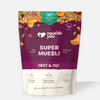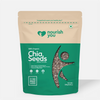
Are vegans responsible for more animal deaths?
"Animals die for vegan food, too!"
The issue of crop deaths - the unintended killing of animals during the harvesting of crops - is a serious issue for ethical vegans, who chose to obtain nutrition from plants to avoid animal cruelty and suffering.
But crop deaths challenge the assumption that plant-based diets are 100% cruelty free.
Let's get into it.
What are crop deaths?
Crop deaths are the unintentional killing of small animals, such as rodents, birds, and snakes, during the process of planting, growing, and harvesting crops.
There are a few different ways small animals are killed in fields:
1. Mechanical harvesting. Modern agriculture relies on machinery for planting and harvesting crops. Machines like combines can hurt or kill animals that live in or around crop fields.
2. Habitat destruction. The conversion of natural habitats into agricultural land displaces wildlife, destroys ecosystems, endangers and kills animals.
3. Pesticides & herbicides. The use of chemical pesticides and herbicides doesn't just target pests but other animals too, including beneficial insects and birds who are harmed or killed by exposure to these chemicals.
4. Field maintenance. Routine agricultural practices such as plowing, tilling and irrigation can disrupt the habitats of ground-nesting birds, small mammals, and other animals who live in crop fields.
Does a vegan diet kill animals?
A vegan diet kills fewer animals than a non-vegan diet, but it is not zero.
For many vegans, the awareness of crop deaths presents an ethical dilemma. While a plant-based diet reduces the direct suffering and slaughter of animals (especially compared to a meat-based diet), it is not completely devoid of animal suffering and death.
But there are a few things vegans and non-vegans should consider within this discussion and within agriculture itself:
1. Land
Our planet's surface is mostly water. Just 29% of the planet's surface is land.
76% of all land on earth is suitable for living or farming.
But, 45% of habitable land is used for agriculture.
And 80% of agriculture land is used for livestock production.
This means that the majority of agricultural land is used for raising livestock, despite providing only 17% of the global calorie supply.
This imbalance is due to the fact that producing meat, fish, dairy, and eggs takes up a lot of precious space. Animals need food themselves, so we have to grow crops to feed them.In fact, this inefficiency means that 43% of all crops grown are fed to farm animals, with cows being the biggest culprits given their size.
But it's not just the food we have to grow for animals; it's also the space needed to roam and graze. In fact, a whopping 70% of agricultural land is used as pastures for grazing animals, even though they provide a small fraction of the meat the world eats.
Now back to crop deaths. Crop deaths exist whether crops are used for human food or animal feed. This is a large reason why consuming plants directly drastically reduces crop deaths and minimises animal suffering - it requires less land to adequately feed people on plants versus animals.
2. Crop distribution
According to a study, 7.3 billion animals die each year (globally) due to plant agriculture.
The study admits that this number is likely higher than the actual number as it does not account for the number of animals who flee fields when they hear machinery approaching them.
In animal farming, large amounts of wheat, corn, and soy are fed to livestock. While soy is often linked to vegan diets, 77% of it is actually fed to farm animals, and only 7% is consumed by humans.
Animal agriculture uses 83% of the world's croplands. Therefore, if plant agriculture causes at most 7.3 billion unintended animal deaths, animal agriculture causes tens of billions more - on top of the billions it kills intentionally for food.
2. Purpose
When it comes to whether a vegan diet kills more animals than a non-vegan diet, numbers are what matter the most.
Animal agriculture intentionally breeds, raises, and slaughters at least 92 billion animals for food every year.
This figure doesn't include farmed fish, which is measured in tonnes rather than individuals, with 178 million tonnes produced each year. Additionally, an estimated 2.7 trillion sea animals are killed annually, either for food or as bycatch.
So, in just one year, animal agriculture kills trillions of sentient beings intentionally. This is nothing compared to the number of unintentional crop deaths, which are at most 7.3 billion each year (mentioned above).
3. Mammal biomass
Biomass is the total mass of living organisms in a given area or ecosystem.
Biomass is usually quantified in terms of dry weight to eliminate the influence of water content and often expressed in units of carbon because carbon is the fundamental building block of life.
By analysing biomass, scientists can assess the impact of human activities on ecosystems.
Around 10,000 years ago, terrestrial mammals weighed about 20 million tonnes of carbon. Today, humans and their livestock dominate the mammal kingdom. That means wild land mammal biomass has plummeted by about 85%.
Wild mammals make up just 4% of the mammal kingdom. This means we have displaced nearly all wildlife on Earth to make room for humans and their food animals.
Humans alone account for one-third of mammal biomass, while livestock make up two-thirds of mammal biomass.
Animal agriculture contributes to animal suffering and ecological harm in huge ways. The expansion of agricultural lands for livestock and their food is a driving force of deforestation globally, which results in the loss of biodiversity, species extinction, and the overall decline of wild animal populations.
In fact, 48% of species are decreasing, 49% remain stable, and just 3% are rising.
How to reduce crop deaths
Current trends to reduce field deaths suggest that plant agriculture will kill much fewer animals in the future, and possibly even none:
1. Wildlife-Friendly Farming: Adopting wildlife-friendly farming practices can significantly reduce crop deaths. These practices include creating wildlife corridors, maintaining hedgerows, and leaving field margins untouched to provide habitats for animals.
2. No-Till Farming: No-till farming is a method of growing crops without disturbing the soil through tillage. This practice can help maintain the natural habitat for many ground-dwelling animals and insects, reducing the disruption caused by traditional plowing.
3. Integrated Pest Management (IPM): IPM involves using a combination of biological, cultural, mechanical, and chemical methods to manage pests in an environmentally and economically sustainable way. By reducing reliance on harmful pesticides, IPM can protect non-target species and overall biodiversity.
4. Technological Innovations: Advances in technology, such as precision agriculture, can help minimise the impact on wildlife. Drones and other monitoring technologies can help farmers identify and protect areas with high wildlife activity, adjusting harvesting practices accordingly.
5. Supporting Regenerative Agriculture: Reducing the disruption of wildlife habitats and lowering chemical use helps protect small animals and insects from harm.
6. Indoor farming. Greenhouses and vertical farms, which are popular in the Netherlands and in Japan reduces the impact on field animals (as well as being more resource-efficient).
Reducing crop deaths is possible through innovation, technology, and policy change:
1. Policy Advocacy: Encouraging policymakers to support and fund sustainable farming practices can lead to broader adoption of methods that reduce crop deaths.
2. Consumer Awareness: Educating consumers about the impacts of agriculture on wildlife can lead to more informed choices and increased demand for sustainably produced foods.
3. Research and Development: Investing in research to develop new technologies and practices that minimize harm to wildlife is essential for creating more sustainable food systems.
Conclusion
A vegan diet is the best diet to minimise animal suffering to the most practical and meaningful degree.
Crop deaths can be reduced as plant agriculture becomes more ethical, sustainable, and efficient.
On the other hand, animal agriculture becomes more cruel as it progresses (think about how factory farming is the solution to meeting large demands for meat and dairy).
Please share your thoughts below!











Comments
Leave a comment